Efficient Degradation of Tetracycline Antibiotics by Engineered Myoglobin with High Peroxidase Activity
Abstract
1. Introduction
2. Results and Discussion
2.1. UV-Vis Studies
2.2. Kinetic Studies
2.3. HPLC Studies
2.4. Product Analysis by UPLC-ESI-MS
2.5. Toxicity of Tetracycline Antibiotics and Their Degradation Products
3. Materials and Methods
3.1. Materials
3.2. UV-Vis Studies
3.3. Kinetic Studies
3.4. HPLC Studies
3.5. Product Analysis by UPLC-ESI-MS
3.6. In vitro Antibacterial Experiments
4. Conclusions
Supplementary Materials
Author Contributions
Funding
Institutional Review Board Statement
Informed Consent Statement
Data Availability Statement
Conflicts of Interest
Sample Availability
References
- Xu, L.; Zhang, H.; Xiong, P.; Zhu, Q.; Liao, C.; Jiang, G. Occurrence, fate, and risk assessment of typical tetracycline antibiotics in the aquatic environment: A review. Sci. Total Environ. 2021, 753, 141975. [Google Scholar] [CrossRef]
- Chan, R.; Chiemchaisri, C.; Chiemchaisri, W.; Boonsoongnern, A.; Tulayakul, P. Occurrence of antibiotics in typical pig farming and its wastewater treatment in Thailand. Emerg. Contam. 2022, 8, 21–29. [Google Scholar] [CrossRef]
- Kokoszka, K.; Zieliński, W.; Korzeniewska, E.; Felis, E.; Harnisz, M.; Bajkacz, S. Suspect screening of antimicrobial agents transformation products in environmental samples development of LC-QTrap method running in pseudo MRM transitions. Sci. Total Environ. 2022, 808, 152114. [Google Scholar] [CrossRef] [PubMed]
- Leichtweis, J.; Vieira, Y.; Welter, N.; Silvestri, S.; Dotto, G.L.; Carissimi, E. A review of the occurrence, disposal, determination, toxicity and remediation technologies of the tetracycline antibiotic. Process Saf. Environ. Prot. 2022, 160, 25–40. [Google Scholar] [CrossRef]
- Gao, R.; Liu, D.; Huang, Y.; Li, G. Preparation of diatomite-modified wood ceramics and the adsorption kinetics of tetracycline. Ceram. Int. 2020, 46, 19799–19806. [Google Scholar] [CrossRef]
- Kumar Palaniswamy, V.; Ramasamy, B.; Manoharan, K.; Raman, K.; Sundaram, R. Enhanced photocatalytic degradation of tetracycline antibiotic using m-BiVO4 photocatalyst under visible light irradiation. Chem. Phys. Lett. 2021, 771, 138531. [Google Scholar] [CrossRef]
- Sun, S.; Shen, J.; Li, D.; Li, B.; Sun, X.; Ma, L.; Qi, H. A new insight into the ARG association with antibiotics and non-antibiotic agents—Antibiotic resistance and toxicity. Environ. Pollut. 2022, 293, 118524. [Google Scholar] [CrossRef]
- Yan, D.-J.; Li, W.; Xiang, Y.; Wen, G.-B.; Lin, Y.-W.; Tan, X. A novel tyrosine-heme C-O covalent linkage in F43Y myoglobin: A new post-translational modification of heme proteins. Chembiochem 2015, 16, 47–50. [Google Scholar] [CrossRef] [PubMed]
- Yang, G.; Gao, Q.; Yang, S.; Yin, S.; Cai, X.; Yu, X.; Zhang, S.; Fang, Y. Strong adsorption of tetracycline hydrochloride on magnetic carbon-coated cobalt oxide nanoparticles. Chemosphere 2020, 239, 124831. [Google Scholar] [CrossRef]
- Zaidi, S.; Sivasankar, V.; Chaabane, T.; Alonzo, V.; Omine, K.; Maachi, R.; Darchen, A.; Prabhakaran, M. Separate and simultaneous removal of doxycycline and oxytetracycline antibiotics by electro-generated adsorbents (EGAs). J. Environ. Eng. 2019, 7, 102876. [Google Scholar] [CrossRef]
- Ni, T.; Feng, H.; Tang, J.; Wang, J.; Yu, J.; Yi, Y.; Wu, Y.; Guo, Y.; Tang, L. A novel electrocatalytic system with high reactive chlorine species utilization capacity to degrade tetracycline in marine aquaculture wastewater. Chemosphere 2022, 300, 134449. [Google Scholar] [CrossRef] [PubMed]
- Zhi, D.; Wang, J.; Zhou, Y.; Luo, Z.; Sun, Y.; Wan, Z.; Luo, L.; Tsang, D.C.W.; Dionysiou, D.D. Development of ozonation and reactive electrochemical membrane coupled process: Enhanced tetracycline mineralization and toxicity reduction. Chem. Eng. J. 2020, 383, 123149. [Google Scholar] [CrossRef]
- Shao, S.; Wu, X. Microbial degradation of tetracycline in the aquatic environment: A review. Crit. Rev. Biotechnol. 2020, 40, 1010–1018. [Google Scholar] [CrossRef] [PubMed]
- Wen, X.; Jia, Y.; Li, J. Degradation of tetracycline and oxytetracycline by crude lignin peroxidase prepared from Phanerochaete chrysosporium—A white rot fungus. Chemosphere 2009, 75, 1003–1007. [Google Scholar] [CrossRef]
- Du, C.; Zhang, Z.; Yu, G.; Wu, H.; Chen, H.; Zhou, L.; Zhang, Y.; Su, Y.; Tan, S.; Yang, L.; et al. A review of metal organic framework (MOFs)-based materials for antibiotics removal via adsorption and photocatalysis. Chemosphere 2021, 272, 129501. [Google Scholar] [CrossRef]
- Phoon, B.L.; Ong, C.C.; Mohamed Saheed, M.S.; Show, P.-L.; Chang, J.-S.; Ling, T.C.; Lam, S.S.; Juan, J.C. Conventional and emerging technologies for removal of antibiotics from wastewater. J. Hazard. Mater. 2020, 400, 122961. [Google Scholar] [CrossRef]
- Tufail, A.; Al-Rifai, J.; Kelso, C.; Fida, Z.; Price, W.E.; Hai, F.I. Coupling horseradish peroxidase based bioreactor with membrane distillation: Elucidating antibiotics degradation and membrane fouling mitigation. Desalination 2022, 542, 116039. [Google Scholar] [CrossRef]
- Yang, L.-H.; Qiao, B.; Xu, Q.-M.; Liu, S.; Yuan, Y.; Cheng, J.-S. Biodegradation of sulfonamide antibiotics through the heterologous expression of laccases from bacteria and investigation of their potential degradation pathways. J. Hazard. Mater. 2021, 416, 125815. [Google Scholar] [CrossRef]
- Li, L.-L.; Yuan, H.; Liao, F.; He, B.; Gao, S.-Q.; Wen, G.-B.; Tan, X.; Lin, Y.-W. Rational design of artificial dye-decolorizing peroxidases using myoglobin by engineering Tyr/Trp in the heme center. Dalton Trans. 2017, 46, 11230–11238. [Google Scholar] [CrossRef]
- Guo, W.-J.; Xu, J.K.; Liu, J.-J.; Lang, J.-J.; Gao, S.-Q.; Wen, G.-B.; Lin, Y.-W. Biotransformation of Lignin by an Artificial Heme Enzyme Designed in Myoglobin With a Covalently Linked Heme Group. Front. Bioeng. Biotechnol. 2021, 9, 664388. [Google Scholar] [CrossRef]
- Zhang, C.; You, S.; Zhang, J.; Qi, W.; Su, R.; He, Z. An effective in-situ method for laccase immobilization: Excellent activity, effective antibiotic removal rate and low potential ecological risk for degradation products. Bioresour. Technol. 2020, 308, 123271. [Google Scholar] [CrossRef] [PubMed]
- Selleck, C.; Larrabee, J.A.; Harmer, J.; Guddat, L.W.; Mitic, N.; Helweh, W.; Ollis, D.L.; Craig, W.R.; Tierney, D.L.; Monteiro Pedroso, M.; et al. AIM-1: An Antibiotic-Degrading Metallohydrolase That Displays Mechanistic Flexibility. Chemistry 2016, 22, 17704–17714. [Google Scholar] [CrossRef] [PubMed]
- Linde, D.; Pogni, R.; Cañellas, M.; Lucas, F.; Guallar, V.; Baratto, M.C.; Sinicropi, A.; Sáez-Jiménez, V.; Coscolín, C.; Romero, A.; et al. Catalytic surface radical in dye-decolorizing peroxidase: A computational, spectroscopic and site-directed mutagenesis study. Biochem. J. 2015, 466, 253–262. [Google Scholar] [CrossRef] [PubMed]
- Shrestha, R.; Chen, X.; Ramyar, K.X.; Hayati, Z.; Carlson, E.A.; Bossmann, S.H.; Song, L.; Geisbrecht, B.V.; Li, P. Identification of Surface-Exposed Protein Radicals and A Substrate Oxidation Site in A-Class Dye-Decolorizing Peroxidase from Thermomonospora curvata. ACS Catal. 2016, 6, 8036–8047. [Google Scholar] [CrossRef]
- Guo, W.-J.; Xu, J.-K.; Wu, S.-T.; Gao, S.-Q.; Wen, G.-B.; Tan, X.; Lin, Y.-W. Design and Engineering of an Efficient Peroxidase Using Myoglobin for Dye Decolorization and Lignin Bioconversion. Int. J. Mol. Sci. 2021, 23, 413. [Google Scholar] [CrossRef]
- Yin, L.-L.; Yuan, H.; Liu, C.; He, B.; Gao, S.-Q.; Wen, G.-B.; Tan, X.; Lin, Y.-W. A Rationally Designed Myoglobin Exhibits a Catalytic Dehalogenation Efficiency More than 1000-Fold That of a Native Dehaloperoxidase. ACS Catal. 2018, 8, 9619–9624. [Google Scholar] [CrossRef]
- Wen, X.; Jia, Y.; Li, J. Enzymatic degradation of tetracycline and oxytetracycline by crude manganese peroxidase prepared from Phanerochaete chrysosporium. J. Hazard. Mater. 2010, 177, 924–928. [Google Scholar] [CrossRef]
- Ding, W.; Lin, X.; Ma, G.; Lu, Q. Designed formation of InVO4/CeVO4 hollow nanobelts with Z-scheme charge transfer: Synergistically boosting visible-light-driven photocatalytic degradation of tetracycline. J. Environ. Chem. Eng. 2020, 8, 104588. [Google Scholar] [CrossRef]
- Khan, M.H.; Bae, H.; Jung, J.-Y. Tetracycline degradation by ozonation in the aqueous phase: Proposed degradation intermediates and pathway. J. Hazard. Mater. 2010, 181, 659–665. [Google Scholar] [CrossRef] [PubMed]
- Hong, P.; Li, Y.; He, J.; Saeed, A.; Zhang, K.; Wang, C.; Kong, L.; Liu, J. Rapid degradation of aqueous doxycycline by surface CoFe2O4/H2O2 system: Behaviors, mechanisms, pathways and DFT calculation. Appl. Surf. Sci. 2020, 526, 146557. [Google Scholar] [CrossRef]
- Park, J.A.; Pineda, M.; Peyot, M.L.; Yargeau, V. Degradation of oxytetracycline and doxycycline by ozonation: Degradation pathways and toxicity assessment. Sci. Total Environ. 2022, 856, 159076. [Google Scholar] [CrossRef]
- Zhao, T.; Zheng, M.; Fu, C.; Li, G.; Xiong, Y.; Qiu, W.; Zhang, T.; Zhang, J.; Zheng, C. Effect of low-level H2O2 and Fe(II) on the UV treatment of tetracycline antibiotics and the toxicity of reaction solutions to zebrafish embryos. Chem. Eng. J. 2020, 394, 125021. [Google Scholar] [CrossRef]
- Du, Z.; Feng, L.; Guo, Z.; Yan, T.; Hu, Q.; Lin, J.; Huang, Y.; Tang, C.; Fang, Y. Ultrathin h-BN/Bi2MoO6 heterojunction with synergetic effect for visible-light photocatalytic tetracycline degradation. J. Colloid Interface Sci. 2021, 589, 545–555. [Google Scholar] [CrossRef]
- Lu, T.; Gao, Y.; Yang, Y.; Ming, H.; Huang, Z.; Liu, G.; Zheng, D.; Zhang, J.; Hou, Y. Efficient degradation of tetracycline hydrochloride by photocatalytic ozonation over Bi2WO6. Chemosphere 2021, 283, 131256. [Google Scholar] [CrossRef]
- Liu, H.; Qu, J.; Zhang, T.; Ren, M.; Zhang, Z.; Cheng, F.; He, D.; Zhang, Y.N. Insights into degradation pathways and toxicity changes during electro-catalytic degradation of tetracycline hydrochloride. Environ. Pollut. 2020, 258, 113702. [Google Scholar] [CrossRef] [PubMed]
- Guo, R.X.; Chen, J.Q. Phytoplankton toxicity of the antibiotic chlortetracycline and its UV light degradation products. Chemosphere 2012, 87, 1254–1259. [Google Scholar] [CrossRef]
- Spina-Cruz, M.; Maniero, M.G.; Guimaraes, J.R. Advanced oxidation processes on doxycycline degradation: Monitoring of antimicrobial activity and toxicity. Environ. Sci. Pollut. Res. Int. 2019, 26, 27604–27619. [Google Scholar] [CrossRef]
- He, T.; Bao, J.; Leng, Y.; Snow, D.; Kong, S.; Wang, T.; Li, X. Biotransformation of doxycycline by Brevundimonas naejangsanensis and Sphingobacterium mizutaii strains. J. Hazard. Mater. 2021, 411, 125126. [Google Scholar] [CrossRef] [PubMed]
- Leng, Y.; Bao, J.; Chang, G.; Zheng, H.; Li, X.; Du, J.; Snow, D.; Li, X. Biotransformation of tetracycline by a novel bacterial strain Stenotrophomonas maltophilia DT1. J. Hazard. Mater. 2016, 318, 125–133. [Google Scholar] [CrossRef]
- Sun, X.; Leng, Y.; Wan, D.; Chang, F.; Huang, Y.; Li, Z.; Xiong, W.; Wang, J. Transformation of Tetracycline by Manganese Peroxidase from Phanerochaete chrysosporium. Molecules 2021, 26, 6803. [Google Scholar] [CrossRef] [PubMed]
- Urayama, P.; Phillips, G.N.; Gruner, S.M. Probing Substates in Sperm Whale Myoglobin Using High-Pressure Crystallography. Structure 2002, 10, 51–60. [Google Scholar] [CrossRef] [PubMed]
- Mangalgiri, K.P.; Ibitoye, T.; Blaney, L. Molar absorption coefficients and acid dissociation constants for fluoroquinolone, sulfonamide, and tetracycline antibiotics of environmental concern. Sci. Total Environ. 2022, 835, 155508. [Google Scholar] [CrossRef] [PubMed]
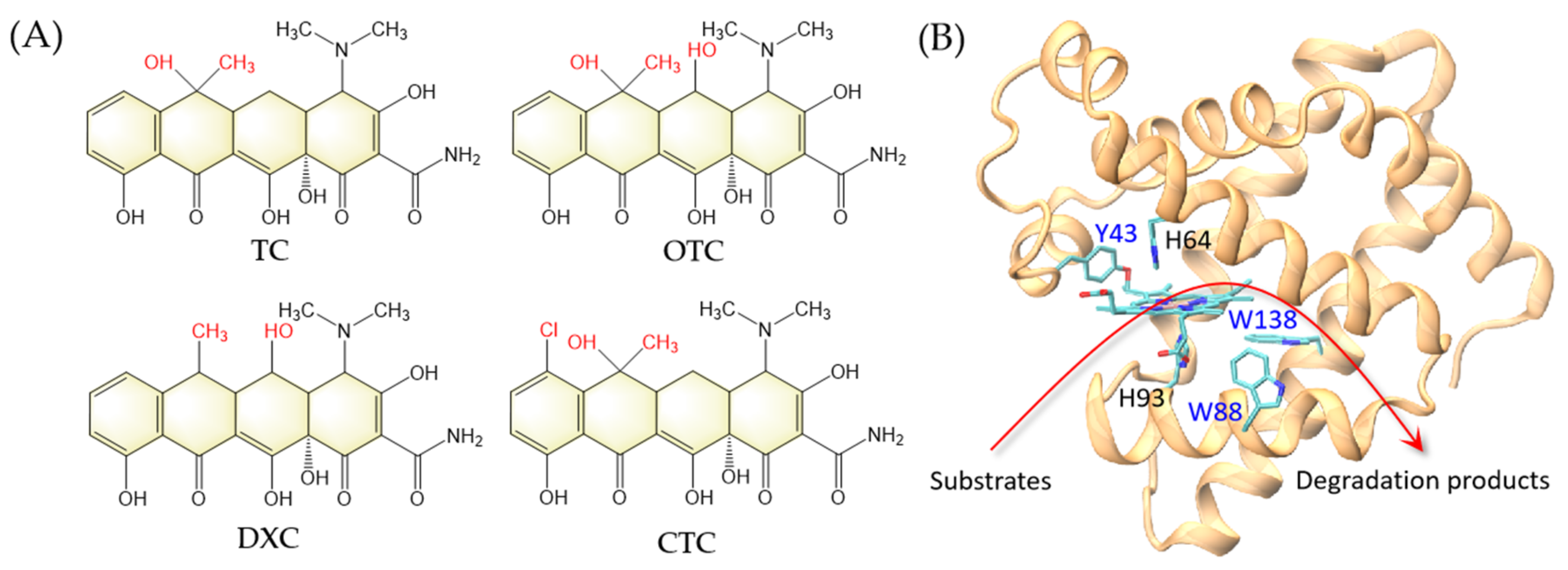
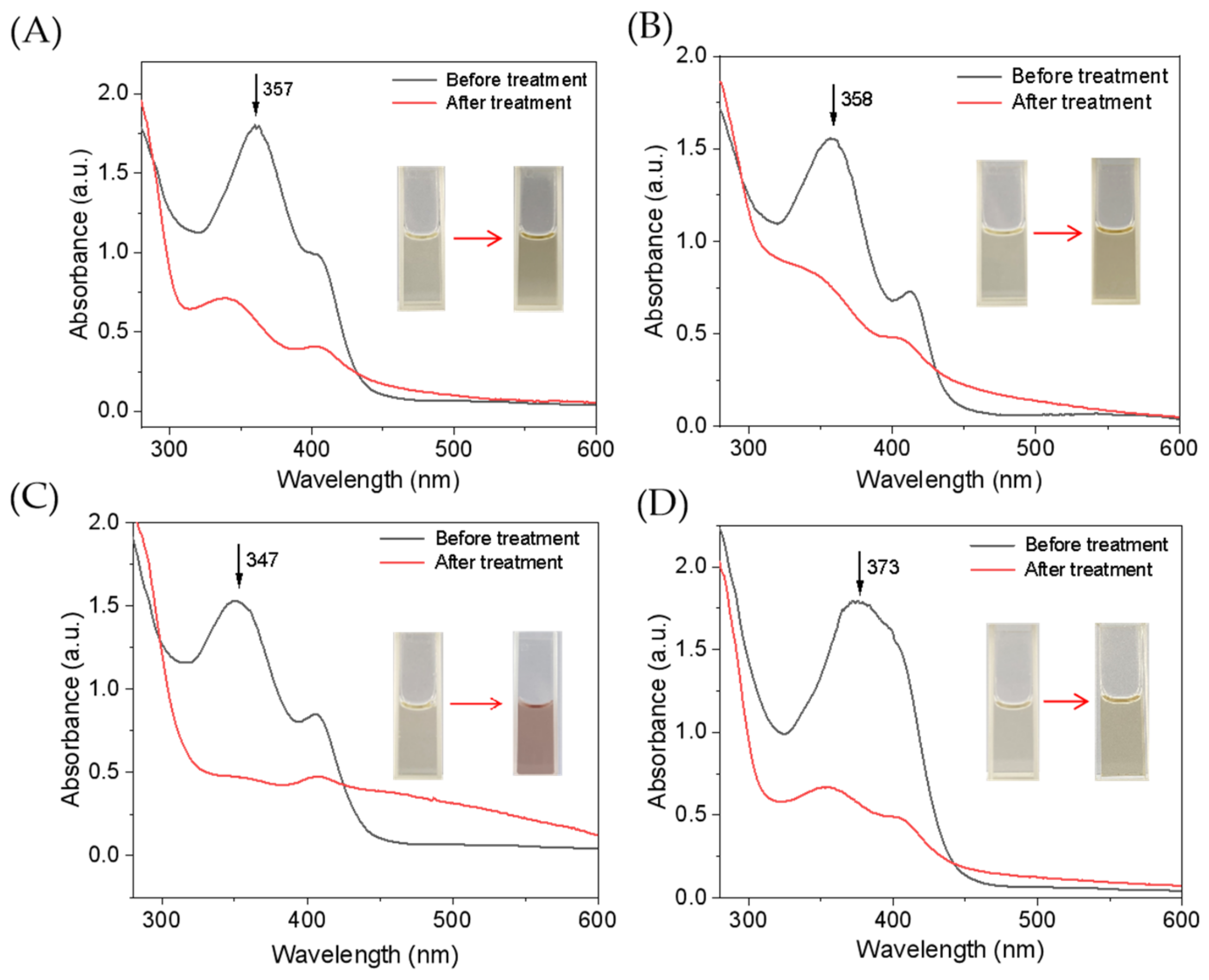
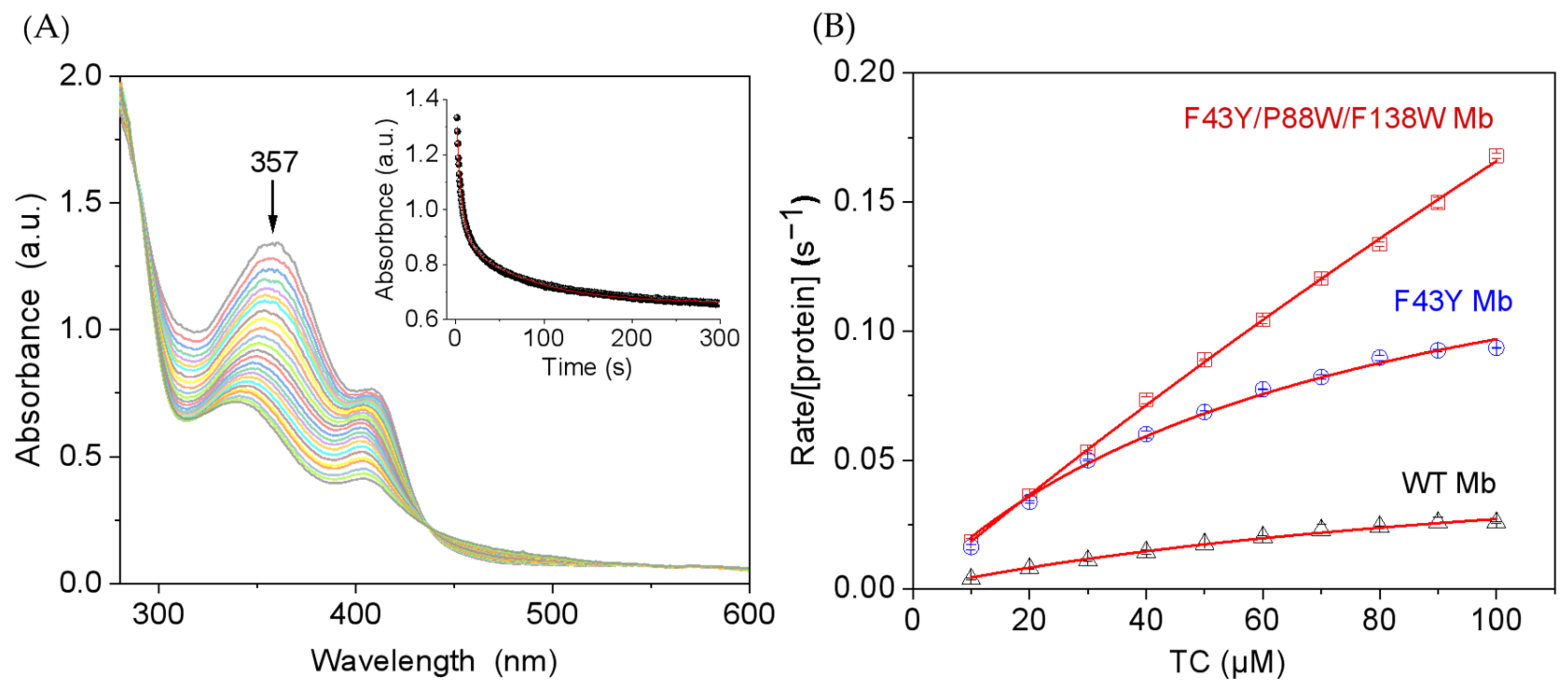
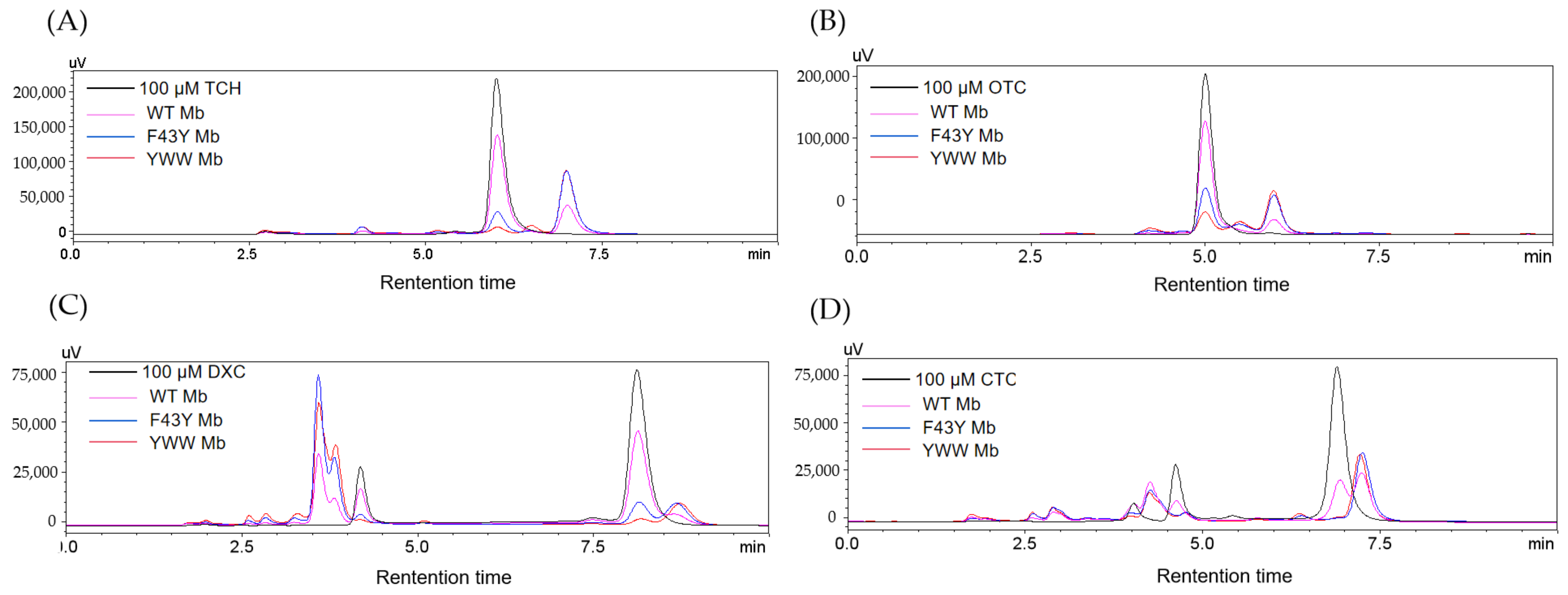
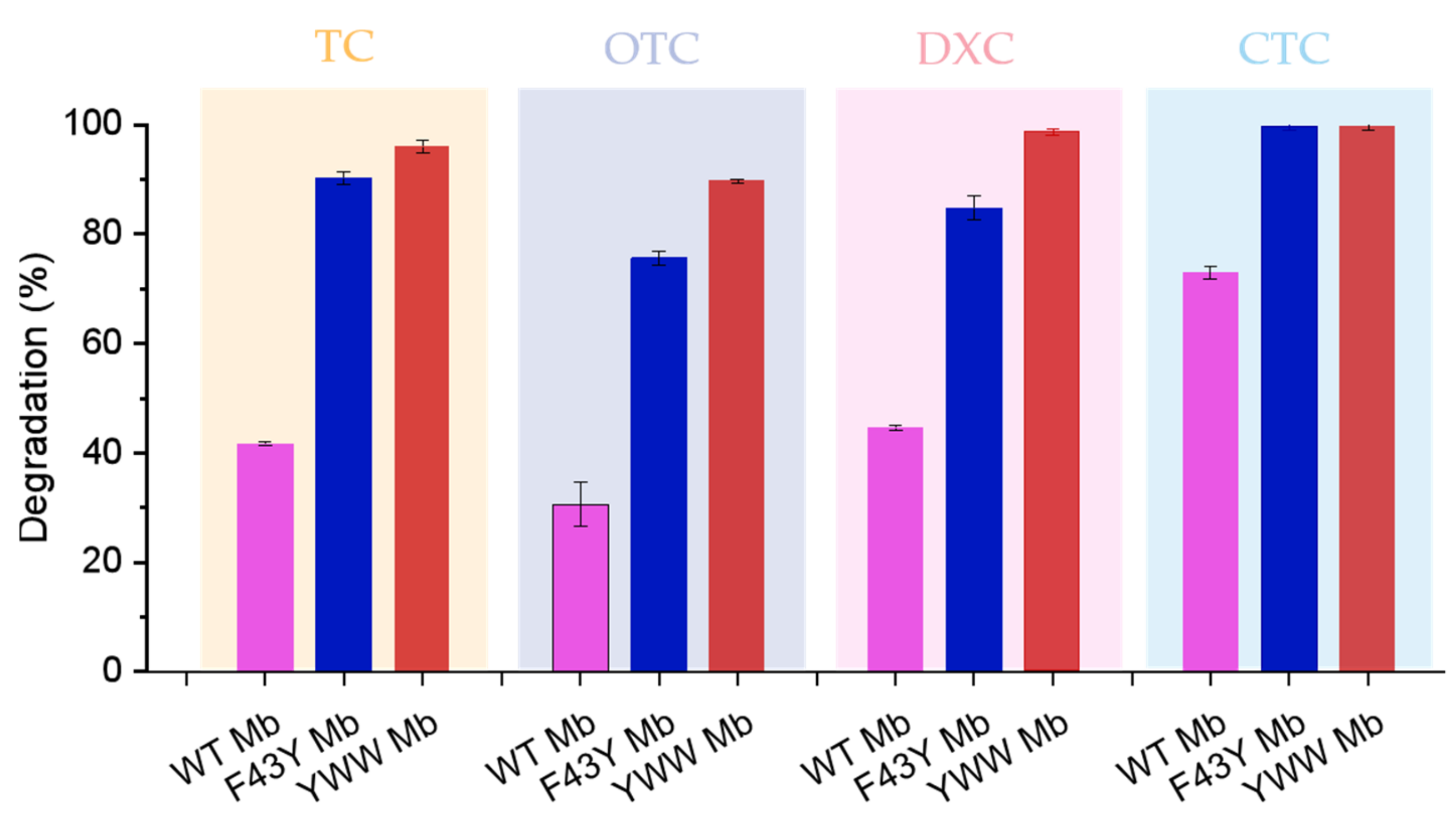
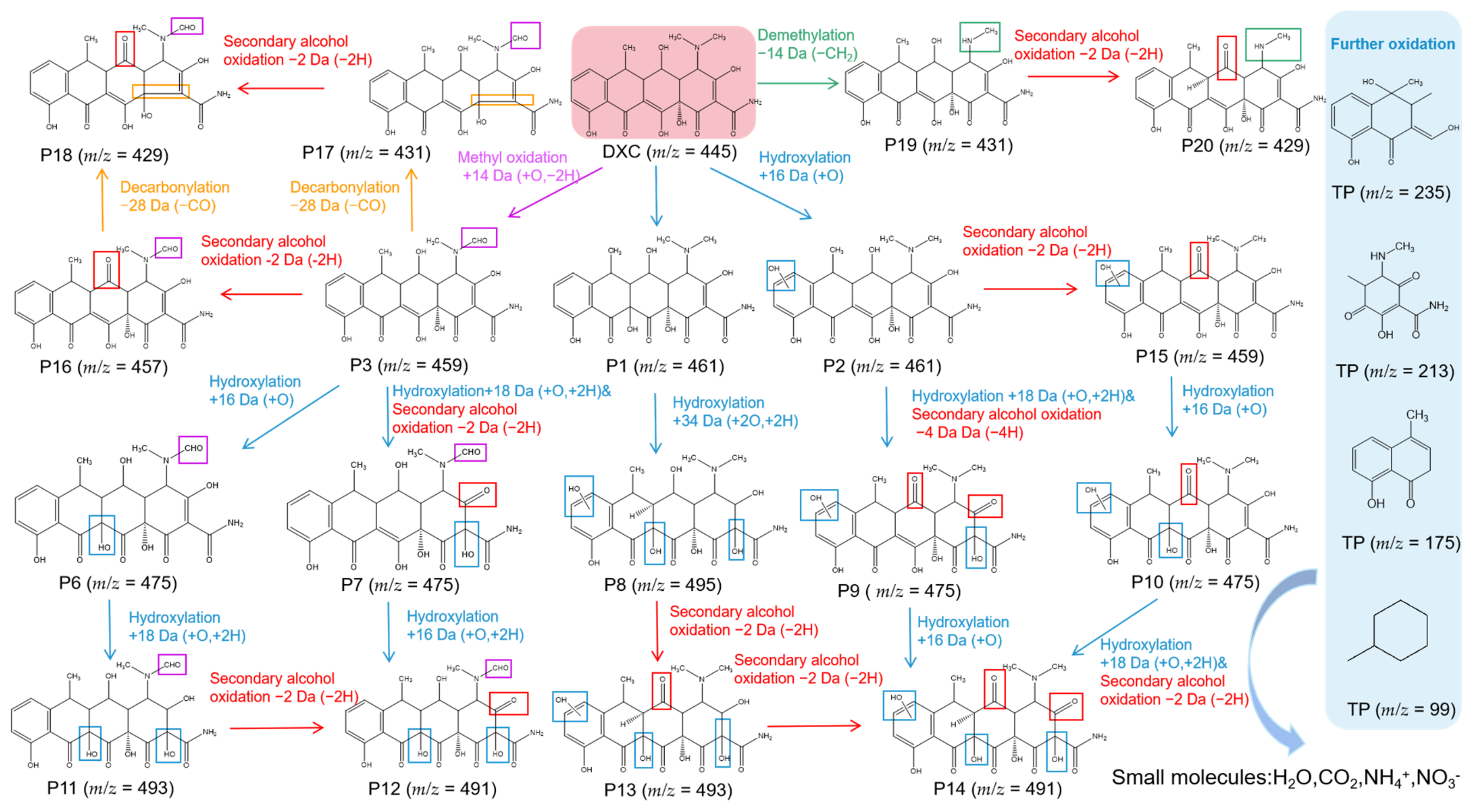
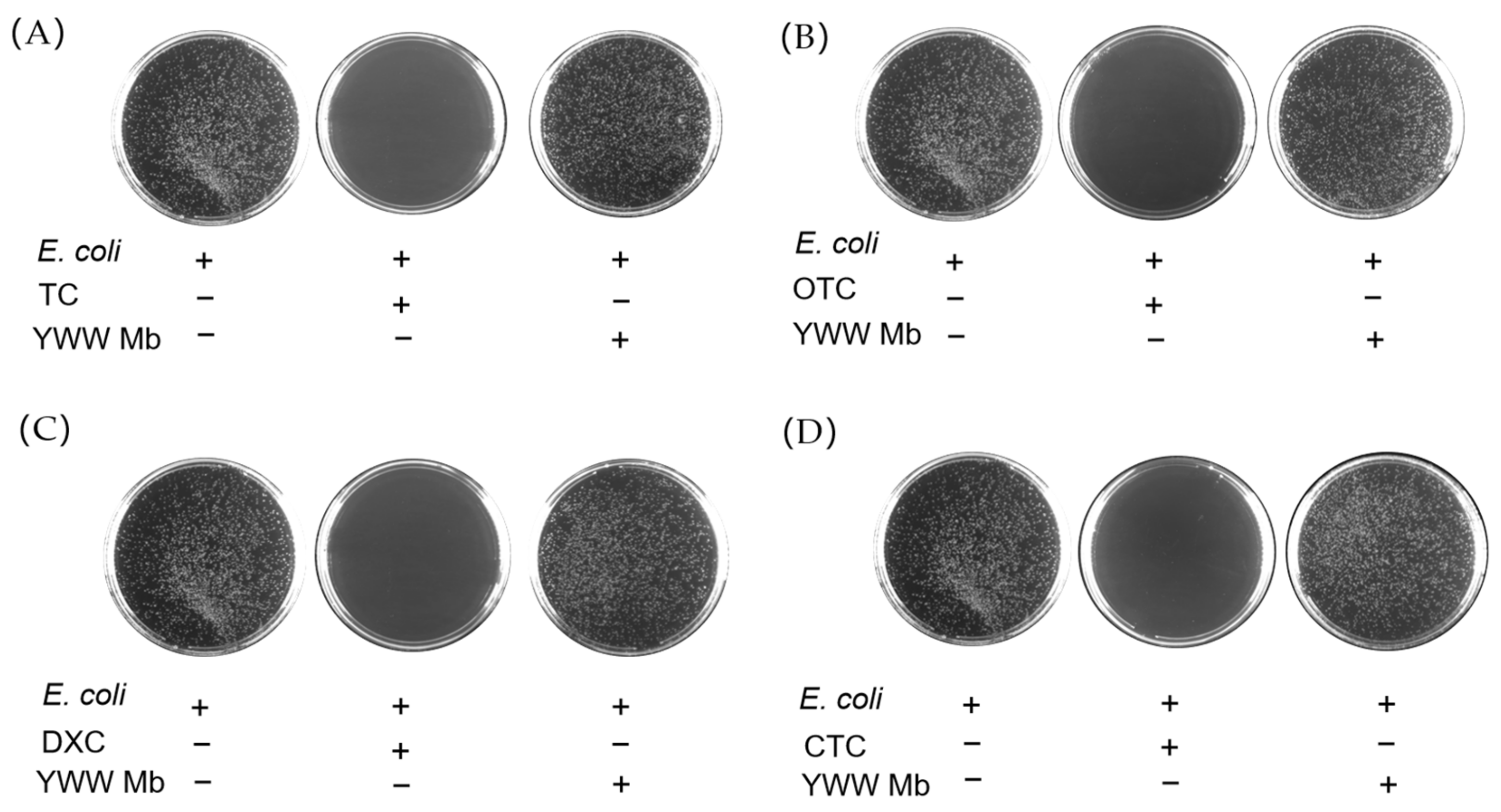
Publisher’s Note: MDPI stays neutral with regard to jurisdictional claims in published maps and institutional affiliations. |
© 2022 by the authors. Licensee MDPI, Basel, Switzerland. This article is an open access article distributed under the terms and conditions of the Creative Commons Attribution (CC BY) license (https://creativecommons.org/licenses/by/4.0/).
Share and Cite
Wu, G.-R.; Sun, L.-J.; Xu, J.-K.; Gao, S.-Q.; Tan, X.-S.; Lin, Y.-W. Efficient Degradation of Tetracycline Antibiotics by Engineered Myoglobin with High Peroxidase Activity. Molecules 2022, 27, 8660. https://doi.org/10.3390/molecules27248660
Wu G-R, Sun L-J, Xu J-K, Gao S-Q, Tan X-S, Lin Y-W. Efficient Degradation of Tetracycline Antibiotics by Engineered Myoglobin with High Peroxidase Activity. Molecules. 2022; 27(24):8660. https://doi.org/10.3390/molecules27248660
Chicago/Turabian StyleWu, Guang-Rong, Li-Juan Sun, Jia-Kun Xu, Shu-Qin Gao, Xiang-Shi Tan, and Ying-Wu Lin. 2022. "Efficient Degradation of Tetracycline Antibiotics by Engineered Myoglobin with High Peroxidase Activity" Molecules 27, no. 24: 8660. https://doi.org/10.3390/molecules27248660
APA StyleWu, G.-R., Sun, L.-J., Xu, J.-K., Gao, S.-Q., Tan, X.-S., & Lin, Y.-W. (2022). Efficient Degradation of Tetracycline Antibiotics by Engineered Myoglobin with High Peroxidase Activity. Molecules, 27(24), 8660. https://doi.org/10.3390/molecules27248660





